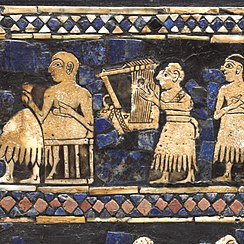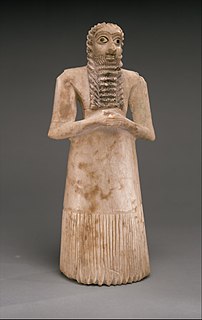 W
WThe Early Dynastic period is an archaeological culture in Mesopotamia that is generally dated to c. 2900–2350 BC and was preceded by the Uruk and Jemdet Nasr periods. It saw the development of writing and the formation of the first cities and states. The ED itself was characterized by the existence of multiple city-states: small states with a relatively simple structure that developed and solidified over time. This development ultimately led to the unification of much of Mesopotamia under the rule of Sargon, the first monarch of the Akkadian Empire. Despite this political fragmentation, the ED city-states shared a relatively homogeneous material culture. Sumerian cities such as Uruk, Ur, Lagash, Umma, and Nippur located in Lower Mesopotamia were very powerful and influential. To the north and west stretched states centered on cities such as Kish, Mari, Nagar, and Ebla.
 W
WThe low tells at Abu Salabikh, around 20 km (12 mi) northwest of the site of ancient Nippur in Al-Qādisiyyah Governorate, Iraq mark the site of a small Sumerian city state of the mid third millennium BCE, with cultural connections to the cities of Kish, Mari and Ebla. Its contemporary name is uncertain: perhaps this was Eresh. Kesh was suggested by Thorkild Jacobsen before excavations began. The Euphrates was the city's highway and lifeline; when it shifted its old bed, in the middle third millennium BCE, the city dwindled away. Only eroded traces remain on the site's surface of habitation after the Early Dynastic Period. The site consists of several mounds, the 12 hectare wall enclosed Main, the 10 hectare Uruk, the West, and the 8 hectare South.
 W
WAdab or Udab was an ancient Sumerian city between Telloh and Nippur. It was located at the site of modern Bismaya or Bismya in the Wasit Province of Iraq.
 W
WTell Agrab is a tell or settlement mound 12.6 miles (20.3 km) southeast of Eshnunna in the Diyala region of Iraq.
 W
WTell Beydar is a village and ancient site in the modern Al-Hasakah Governorate, Syria. It was the Ancient Near Eastern city of Nabada. It is connected by road to Al-Darbasiyah on the Turkish border in the north.
 W
WTell Chuera is an ancient Near Eastern tell site in Raqqa Governorate, northern Syria. It lies between the Balikh and Khabur rivers.
 W
WEnsi was a Sumerian title designating the ruler or prince of a city-state. Originally it may have designated an independent ruler, but in later periods the title presupposed subordinance to a lugal.
 W
WEshnunna was an ancient Sumerian city and city-state in central Mesopotamia. Although situated in the Diyala Valley north-west of Sumer proper, the city nonetheless belonged securely within the Sumerian cultural milieu.
 W
WGilgamesh and Aga, sometimes referred to as incipit The envoys of Aga is an Old Babylonian poem written in Sumerian. The only one of the five poems of Gilgamesh that has no mythological aspects, it has been the subject of discussion since its publication in 1935 and later translation in 1949.
 W
WGirsu was a city of ancient Sumer, situated some 25 km (16 mi) northwest of Lagash, at the site of modern Tell Telloh, Dhi Qar Governorate, Iraq.
 W
WKhafajah or Khafaje is an archaeological site in Diyala Province (Iraq). It was part of the city-state of Eshnunna. The site lies 7 miles (11 km) east of Baghdad and 12 miles (19 km) southwest of Eshnunna.
 W
WThe Lyres of Ur or Harps of Ur are considered to be the world's second oldest surviving stringed instruments after the ones discovered in the Maykop culture. In 1929, archaeologists led by the British archaeologist Leonard Woolley, representing a joint expedition of the British Museum and the University of Pennsylvania Museum of Archaeology and Anthropology, discovered the instruments when excavating the Royal Cemetery of Ur between from 1922 and 1934. They discovered pieces of three lyres and one harp in Ur, located in what was Ancient Mesopotamia and is contemporary Iraq. They are over 4,500 years old, from ancient Mesopotamia during the Early Dynastic III Period. The decorations on the lyres are fine examples of the court art of Mesopotamia of the period.
 W
WMari was an ancient Semitic city-state in modern-day Syria. Its remains constitute a tell located 11 kilometers north-west of Abu Kamal on the Euphrates river western bank, some 120 kilometers southeast of Deir ez-Zor. It flourished as a trade center and hegemonic state between 2900 BC and 1759 BC. As a purposely-built city, the existence of Mari was related to its position in the middle of the Euphrates trade routes; this position made it an intermediary between Sumer in the south and the Eblaite kingdom and the Levant in the west.
 W
WSippar was an ancient Near Eastern Sumerian and later Babylonian city on the east bank of the Euphrates river. Its tell is located at the site of modern Tell Abu Habbah near Yusufiyah in Iraq's Baghdad Governorate, some 60 km north of Babylon and 30 km southwest of Baghdad. The city's ancient name, Sippar, could also refer to its sister city, Sippar-Amnanum ; a more specific designation for the city here referred to as Sippar was Sippar-Yahrurum.
 W
WThe Statue of Ebih-Il is a 25th-century BC statue of the praying figure of Ebih-Il, superintendent of the ancient city-state of Mari in modern eastern Syria. The statue was discovered at the Temple of Ishtar in Mari during excavations directed by French archaeologist André Parrot. It is made of gypsum, with inlays of schist, shells and lapis lazuli. Claire Iselin of the Musée du Louvre, where the statue is displayed, describes it as "a masterpiece by virtue of its craftsmanship, state of preservation, and expressive style."
 W
WThe Stele of the Vultures is a monument from the Early Dynastic III period in Mesopotamia celebrating a victory of the city-state of Lagash over its neighbour Umma. It shows various battle and religious scenes and is named after the vultures that can be seen in one of these scenes. The stele was originally carved out of a single slab of limestone, but only seven fragments are known today. The fragments were found at Tello in southern Iraq in the late 19th century and are now on display in the Louvre. The stele was erected as a monument to the victory of king Eannatum of Lagash over Ush, king of Umma.
 W
WThe Tell Asmar Hoard are a collection of twelve statues unearthed in 1933 at Eshnunna in the Diyala Governorate of Iraq. Despite subsequent finds at this site and others throughout the greater Mesopotamian area, they remain the definitive example of the abstract style of Early Dynastic temple sculpture.